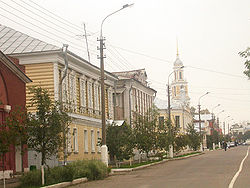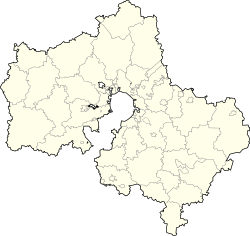Kolomna
| Kolomna (English) Коломна (Russian) |
|
|---|---|
| - City - | |
 Historic center of Kolomna |
|
 Location of Moscow Oblast in Russia |
|
|
|
|
|
|
|
|
|
|
| Administrative status (as of January 2013) | |
| Country | Russia |
| Federal subject | Moscow Oblast |
| Administratively subordinated to | Kolomna City Under Oblast Jurisdiction |
| Administrative center of | Kolomensky District, Kolomna City Under Oblast Jurisdiction |
| Municipal status (as of May 2010) | |
| Urban okrug | Kolomna Urban Okrug |
| Administrative center of | Kolomna Urban Okrug, Kolomensky Municipal District |
| Head | Valery Shuvalov |
| Representative body | Council of Deputies |
| Statistics | |
| Area (urban okrug) (May 2010) | 67.12 km2 (25.92 sq mi) |
| Population (2010 Census) | 144,589 inhabitants |
| - Rank in 2010 | 119th |
| Density | 2,154/km2 (5,580/sq mi) |
| Time zone | MSK (UTC+03:00) |
| Founded | 1177 |
| Postal code(s) | 140400 |
| Dialing code(s) | +7 496 |
|
|
|
| on | |
Kolomna (Russian: Колóмна; IPA: [kɐˈlomnə]) is an ancient city of Moscow Oblast, Russia, situated at the confluence of the Moskva and Oka Rivers, 114 kilometers (71 mi) (by rail) southeast of Moscow. Population: 144,589 (2010 Census);150,129 (2002 Census);161,881 (1989 Census).
Mentioned for the first time in 1177, Kolomna was founded in 1140–1160 according to the latest archaeological surveys. Kolomna's name may originate from the Old Russian term for "on the bend (in the river)", especially as the old city is located on a sharp bend in the Moscow River. In 1301, Kolomna was incorporated into the Moscow Principality.
Like some other ancient Russian cities, it has a kremlin, which is a citadel similar to the more famous one in Moscow and also built of red brick. The stone Kolomna Kremlin was built from 1525–1531 under the Russian Tsar Vasily III. The Kolomna citadel was a part of the Great Abatis Border and, although much of the surrounding wall was removed in the eighteenth century and materials used to construct other public buildings, the remaining stretch of wall, several towers, and some interior buildings have been preserved and held in a good shape. A museum is located inside. In front of the façade stands a statue of Dmitry Donskoy, celebrating the gathering of his troops in Kolomna prior to the Battle of Kulikovo in 1380.
...
Wikipedia



